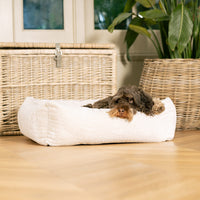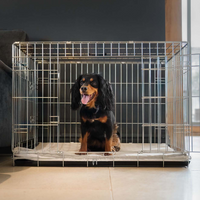Dog anxiety is a common issue that can affect our furry friends in various ways, leaving pet owners feeling unsure of how to help. Whether it’s separation anxiety in dogs, fear of car rides, or general nervousness, understanding the root of the problem and finding effective solutions can make all the difference. If you’re saying, “My dog has anxiety, and I don’t know what to do,” this guide is here to help you navigate the challenge and provide relief for your beloved companion.
What Are Dog Anxiety Symptoms?
Recognising the signs of anxiety in dogs is the first step to addressing the issue. While symptoms can vary, some common ones include:
- Excessive barking or whining
- Pacing or restlessness
- Destructive behaviour (e.g., chewing furniture or shoes)
- Trembling or shaking
- Hiding or trying to escape
- Loss of appetite
- Excessive licking or grooming
If you notice these dog anxiety symptoms regularly, it’s essential to identify the triggers and consider solutions tailored to your dog’s needs.
Common Types of Dog Anxiety

- Separation Anxiety in Dogs: This is one of the most prevalent forms of anxiety. Dogs with canine separation anxiety often struggle when left alone, leading to behaviours like excessive barking, destructive chewing, or attempts to escape.
- Dog Car Anxiety: Car rides can be a source of stress for some dogs. Symptoms like trembling, panting, or refusing to enter the vehicle indicate discomfort. This anxiety might stem from motion sickness, past negative experiences, or unfamiliarity.
- Puppy Separation Anxiety: Puppies may experience heightened anxiety when first adjusting to a new home or when left alone for the first time. Early intervention is key to preventing long-term issues.
Tips for Treating Separation Anxiety in Dogs and Other Types of Anxiety
Helping your anxious dog requires a combination of understanding, patience, and practical strategies. Here are some effective steps to consider:
1. Establish a Routine
Dogs thrive on consistency. Creating a predictable daily schedule for feeding, walks, and playtime can help reduce uncertainty and provide a sense of security.
2. Provide a Safe Space
Investing in a dedicated, cosy spot where your dog feels secure can be incredibly calming. Our faux fur anti-anxiety calming bed collection is designed to provide ultimate comfort, mimicking the warmth and security of a mother’s embrace.

3. Use Calming Aids
Certain products can help alleviate anxiety, such as:
- Calming Diffusers and Spot-On Treatments: These release pheromones or natural calming agents to create a relaxed environment for your dog. We love the Pet Remedy All In One Calming Kit, it includes a plug-in diffuser, a calming spray and calming wipes - the perfect way to figure out what’s going to help calm your dog.
- Calming Toys: Chew toys or puzzle toys can help distract your dog and reduce stress by keeping their mind occupied. Explore our range of interactive toys for dogs with anxiety to help keep your anxious pups mind busy.
4. Gradual Desensitisation
If your dog has separation anxiety, practice short departures to help them get used to being alone. Gradually increase the time apart, ensuring you always return before they become distressed.
5. Seek Professional Therapy for Dogs with Anxiety
In severe cases, consulting a professional dog trainer or behaviourist can provide tailored solutions. They can guide you through techniques like counterconditioning and desensitisation.
6. Calming Treatments and Supplements
Consider calming treatments for dogs such as natural supplements or vet-prescribed solutions. These can complement behavioural strategies to provide additional support. Shop our range of calming supplements here
7. Help for Dog Car Anxiety
For car-related stress, take steps to make the experience more comfortable:
- Start with short trips to positive destinations like a park.
- Use a secure harness or crate for safety and comfort.
- Bring familiar items like their favourite blanket or toy.
Why Addressing Anxiety Is Crucial
Ignoring anxiety can lead to worsening symptoms and a lower quality of life for your pet. Prolonged stress can impact their physical health, leading to issues like weight loss or a weakened immune system. Addressing anxiety not only ensures their happiness but strengthens the bond between you and your dog.
How Lords & Labradors Can Help

At Lords & Labradors, we understand how much you care about your pet’s well-being. That’s why we offer a range of high-quality products designed to support dogs with anxiety:
- Faux Fur Anti-Anxiety Calming Beds: The ultimate retreat for your dog, providing a safe and soothing space.
- Calming Diffusers and Spot-On Treatments: Effective and easy-to-use solutions to create a stress-free environment.
- Calming Toys: Engaging and therapeutic toys to distract and relax your furry friend.
Shop our curated collection and discover the perfect anxiety help for dogs today. Explore our range here.
Final Thoughts
If your dog has anxiety, remember that you’re not alone, and there are many tools and strategies available to help. By recognising the symptoms, identifying the triggers, and implementing calming measures, you can significantly improve your pet’s quality of life. With patience, love, and the right support, your dog can feel happy, secure, and anxiety-free.
If you’re ready to take the next step in supporting your furry friend, browse our selection of calming products at Lords & Labradors today!
































































































